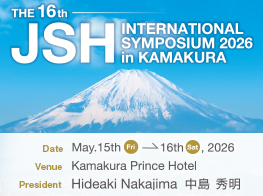
名前:千葉 雅尋【北海道大学医学部血液内科】
発表形式:e-Poster
Title:
Whole-genome CRISPR library screens identify CD48 as an essential molecule in adult T-cell leukemia/lymphoma for defining susceptibility to natural killer cell-mediated cytotoxicity
Authors:
Masahiro Chiba1, Joji Shimono1, Takashi Ishio1, Hideki Goto1, Michiyuki Maeda2, Satoshi Hashino3, Takanori Teshima1, Masao Nakagawa1
Affiliations:
1. Department of Hematology, Hokkaido University Faculty of Medicine, Sapporo, Hokkaido, Japan
2. Institute for Virus Research, Kyoto University, Sakyo-ku, Kyoto, Japan
3. Health Care Center, Hokkaido University, Sapporo, Japan
Abstract:
Background: Adult T-cell lymphoma/leukemia (ATLL) is a mature T-cell neoplasm and its prognosis is poor. Human T-cell leukemia virus type 1 (HTLV-1) is the causative retrovirus of ATL and it infects infants’ CD4 positive T cell through breast feeding. A fraction of the HTLV-1 infected individuals develops ATLL after more than 50 years. During the long latency period genetic alterations and aberrant gene expression accumulate extensively in ATLL cells. In particular, ATLL has high frequency of somatic mutations, genomic losses and epigenetic silencing in human leukocyte antigen (HLA)-A, HLA-B and β2 microglobulin, highlighting immune escape from T-cells as a hallmark of ATLL. In theory this "missing self" increases susceptibility to natural killer (NK) cell-mediated killing but it remains unknown how ATLL cells evade NK cell-mediated immunosurveillance. In fact, activation of NK cells is controlled by signal integration from multiple stimulatory and inhibitory receptors on their cell surface so that functional elucidation for the key mechanism by which ATLL cells evade NK-mediated immune surveillance remains challenging.
Aims: The aim of this study was to identify ATLL cell-intrinsic molecules which play essential roles for immune evasion from NK cell-mediated cytotoxicity against ATLL.
Methods: Two Cas9-expressing ATLL cell lines were lentivirally transduced with the human clustered regularly interspaced short palindromic repeat (CRISPR) Brunello pooled library (Addgene #73178) of 76,441 single-guide RNAs targeting 19,114 protein-coding genes, selected by puromycin, cultivated for 2 weeks enough to have genes fully inactivated by sgRNAs. The cells were co-cultured with human YT1 NK cells at 1:2 of effector:target ratio for 24-48 hours. Mogamulizumab, anti-human CCR4 monoclonal antibody, was added to the effector/target cell mixture, which enabled us to evaluate the responsible genes for both direct NK cytotoxicity and mogamulizumab-mediated antibody dependent cellular cytotoxicity (ADCC). Resistance genes were those for which the corresponding sgRNAs were enriched in the screening cell pool relative to the cell pool without screening. MAGeCK algorithm was used to rank target genes enriched in the screening.
Results: Twenty genes were overlapped between top-ranked 500 genes in two ATLL cell lines. As a proof of concept, CCR4 was identified as the best overlapped gene, confirming the reliability of our screening. One of the other overlapped genes was CD48, which is a signaling lymphocyte activation molecule (SLAM) family cell surface receptor and is an activating NK cell receptor by ligating 2B4 receptor on NK cells. Through further analysis, the ability of CD48 knockout ATLL cells for evading NK cell-mediated direct cytotoxicity was confirmed by using not only a NK cell line but also human primary NK cells with reduced interferon gamma induction and degranulation. Notably, we found that primary ATLL cells reduced their CD48 mRNA expression along with aggressiveness of clinical subtypes.
Summary/Conclusion: Our findings indicated that CD48 is an essential molecule in ATLL for defining susceptibility to NK cell-mediated cytotoxicity. Thus, this study improved our current understanding of the mechanisms for immune evasion in ATLL and provides a rationale for evaluation of CD48 as a biomarker for NK cell-based immunotherapies in the future.
The EHA2021 受賞レポート
この度はThe European Hematology Association(EHA) 2021 Virtual Congress への参加にあたり,日本血液学会JSH Abstract Achievement Award for The EHA2021にご採択いただき誠にありがとうございます。今回のEHAは2021年6月9日から17日にわたり開催されました。開催地に関しましては現在のCOVID-19の流行の影響で昨年と同様にOn lineでの開催になりました。On lineではありますが、今回のEHAが私の初めての海外学会での参加になり、基礎・臨床においてハイレベルな発表・講演が行われており、大変勉強になりました。
私は今回、成人T細胞性白血病/リンパ腫(ATLL)のNK細胞の免疫についての実験結果を報告いたしました。私の所属する研究室では、我が国に高頻度かつ極めて治療抵抗性である成人T細胞性白血病/リンパ腫(ATLL)に対してFunctional genomics解析を推進し、2018年には過去に見出されなかった免疫関連転写因子複合体BATF3/IRF4が細胞生存増殖を司ることを明らかにいたしました。shRNAスクリーニングにより様々な疾患に対して治療分子標的が同定されておりますが、ノックダウンが不十分な場合やshRNA自体によるoff-target効果が生じることがあり、より多くの遺伝子を対象とするには別のアプローチが必要であると考えてました。そして、今回は先進的ゲノム編集技術CRISPR/Cas9を用い、ゲノムワイドなLoss-of-functionを行ったATLLとNK細胞を共培養してNK細胞からの免疫逃避に関わる遺伝子について網羅的なスクリーニングを施行しました。CRISPRスクリーニングの結果、ATLL細胞のCD48がNK細胞の細胞傷害能力に非常に重要であることが示唆されました。確認実験として実際にCD48 KOのATLL cell lineにNK cell lineまたは健常人のNK細胞と共培養を行ったところ、CD48KOのATLL cellはコントロールのATLL cellよりも有意に生存しておりました。ATLL患者のNK細胞を用いても上記と同様の結果になりました。そして、public mRNAのデータセットの解析を行い、ATLLでは病勢進行に伴いCD48が低下していることを見出しました。上記からATLLは病勢進行に伴い、CD48が低下し、NK細胞からの免疫を回避している可能性が示唆されました。ATLLの免疫チェックポイント阻害薬や、CAR-NK療法におけるバイオマーカーとしてCD48が重要である可能性があると考えております。
疾患の頻度から考えても当然ではありますが、B細胞性リンパ腫に関してT細胞性リンパ腫の発表は限られておりましたが、その中でも今回の我々の報告に興味をもっていただき、閲覧していただき、良かったです。
ほかの発表では分子標的薬、免疫チェックポイント阻害薬、CAR-T療法の報告が盛んに行われておりました。現在私の所属する北海道大学血液内科においてもCAR-T療法の臨床を積極的に行っており、また自分自身でもCAR-T細胞の作製を行っており、学びが多かったです。今後自分の研究・臨床に今回のEHAで勉強したことをいかしていき、患者さんに還元できるように日々精進していきたいと存じます。
最後になりましたが,今回このような素晴らしい機会をいただきまして大変ありがとうございました。今回の機会を与えてくださった日本血液学会・国際委員会の先生方,日本血液学会事務局の皆様に深謝いたします。また、いつもご指導いただいている中川雅夫先生をはじめとして私の研究を進めるためにご協力いただいたすべての皆様に心より御礼を申し上げます。



